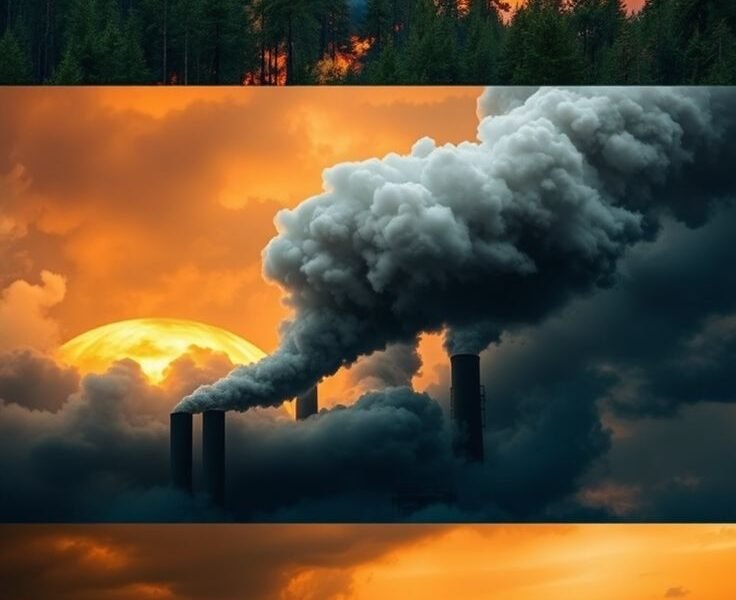Antarctica’s Singing Glaciers: Decoding Ice Vibrations to Predict Climate Tipping Points
Introduction
Antarctica’s mysterious and silent ice sheets are actually presenting a continuous and enigmatic symphony—a sound that is inaudible to the human ear but holds deep indicators for our planet’s future. This concept of “singing glaciers” reflects a new and revolutionary scientific research that is trying to understand the vibrations and resonance of the continent’s ice masses. This is not merely an interesting phenomenon; it is a tool that can tell us about those delicate turning points in Earth’s climate system where small changes can cause catastrophic and irreversible consequences. As Earth’s temperature rises, Antarctica’s glaciers are melting, sea levels are rising, and the future of coastal areas worldwide is at risk. By decoding the sounds of these singing ice sheets, scientists are trying to detect internal changes in their structure, their melting process, and their potential risks of collapsing into the ocean. This research not only tells us about Antarctica’s current condition but also provides valuable information about our world’s shape in the coming centuries.
Symphony of the Silent Continent: A World of Sounds
The story of Antarctica’s singing glaciers is essentially a story of a symphony that is telling us about Earth’s future. This symphony consists of extremely low-frequency sounds that are inaudible to human ears, but we can record and analyze them through modern scientific instruments. Studying these sounds helps us understand how Antarctica’s ice sheets are undergoing changes and what these changes mean for our planet’s future. These sounds are produced by the glaciers’ internal structure, the structure of the land beneath them, and water flow. When wind passes over ice fields or water flows beneath the ice, it creates vibrations that spread through the ice masses. By studying these sounds, scientists can obtain information about the internal conditions of glaciers, much like how a doctor listens to a patient’s chest to assess the condition of their heart and lungs. This research provides us with valuable information about the future of Antarctica’s ice sheets and alerts us to the potential impacts of climate change.
How Ice Music is Created: Vibration Triggers
The music of singing glaciers is produced from various sources, with each source producing a unique type of sound that provides specific information about the glacier’s condition. The first and most important source is wind that blows over ice cracks and glacier surfaces, producing low-frequency vibrations. These vibrations tell us about the surface structure of the glacier and the cracks present in it. The second important source is water that flows beneath glaciers. When water passes beneath ice masses, it creates friction that appears as resonance. This resonance tells us about the amount and flow of water beneath the glacier. The third source is the self-generated movement of glaciers. Glaciers continuously move very slowly, and this movement creates pressure that appears as vibrations. Each type of movement produces a unique sound, which proves to be a key for scientists to understand the glacier’s health. Analyzing these sounds helps us understand how glaciers are changing their structure and movement in response to climate changes.
Listening Instruments: Tools for Ice Songs
To record these silent sounds, scientists are using state-of-the-art instruments that are extremely sensitive and accurate. Seismometers are the primary means of recording these sounds. These instruments detect vibrations occurring on the Earth’s surface and convert them into electronic signals. Seismometers installed in Antarctica are continuously recording the sounds of glaciers, including extremely low-frequency sounds that are beyond human hearing range. In addition, ice-penetrating radar is also being used, which studies the thickness and internal structure of glaciers. These radar systems help detect internal cavities, cracks, and water reservoirs within glaciers. Besides these instruments, scientists are also using advanced microphone systems specifically designed to record low-frequency sounds. All these instruments together present a comprehensive picture of glacier health and help scientists understand how glaciers are changing in response to climate changes.
Sound Analysis: The Art of Signal Processing
Analyzing recorded sounds is a complex and detailed process that involves advanced computer algorithms and signal processing techniques. Scientists separate different frequencies and study them, with each frequency band indicating some specific condition of the glacier. For example, sudden sharp sounds could be a sign of cracking or breaking of ice masses. Continuous resonating sounds could indicate water flow beneath the glacier. Modern computer algorithms are helping scientists recognize and interpret patterns in these sounds. These algorithms can detect changes in sounds over time and tell scientists whether the glacier’s condition is stable or changing. This analysis process includes advanced techniques such as spectral analysis, waveform recognition, and pattern matching. All these techniques together help scientists understand the complex language of glaciers.
Temperature Effect: Changing Sounds with Heat
As Earth’s temperature rises, the sounds of glaciers are changing, and these changes are providing us with valuable information about the impacts of climate change. Research has revealed that in warmer weather, glacier sounds become louder and sharper. This change occurs due to ice melting and cracking caused by higher temperatures. When temperature increases, the melting process on glacier surfaces accelerates, which increases the amount of water. This water collects beneath and inside glaciers, increasing pressure and causing changes in vibrations. Additionally, glacier movement also changes in warmer weather, which is reflected in their sounds. Studying these changes helps us understand how temperature rise is affecting the structure and speed of glaciers. This information helps us make predictions about the future effects of climate change.
Ice Mass Stability: Assessment Through Sounds
The study of singing glaciers’ sounds provides us with an effective means to check the stability of ice masses. When cracks form in a glacier or it weakens, its sound changes significantly. Scientists can observe these changes and estimate whether a glacier is at risk of breaking. For example, if a glacier’s sound suddenly becomes sharper or its frequency changes, this could be a sign that cracks are forming in the glacier or it is losing its stability. This information is particularly important for those ice masses that can cause sea level rise. If large glaciers break and fall into the ocean, it could cause sudden and significant sea level rise, with devastating consequences for coastal areas. Therefore, assessing glacier stability through their sounds is an important scientific endeavor.
Sea Level: Global Impact of Glaciers
The melting of Antarctica’s glaciers directly affects sea level, and the study of singing glaciers is helping us better understand this process. If all of Antarctica’s ice melts, sea level could rise by approximately 60 meters, which would have devastating consequences for coastal areas worldwide. The study of glacier sounds can help us understand how quickly this process is occurring. By comparing sounds of different glaciers, scientists can estimate which glacier will be most responsible for sea level rise. For example, glaciers that are melting rapidly or breaking apart provide information about their condition through their sounds. Based on this information, scientists can predict how much sea level will rise in the coming decades and which areas will be most affected. This information could prove extremely valuable for policymakers.
Climate Change: Monitoring Through Sounds
Singing glaciers are sensitive indicators of climate change, and changes in their sounds are directly linked with changes in global temperature. Scientists can monitor the effects of climate change through these sounds. This method can provide more sensitive and immediate results compared to traditional methods. For example, if a glacier’s sound changes, this change is immediately recorded and scientists can analyze it. In contrast, traditional methods involve measuring glacier thickness and area, which is a time-consuming process. The monitoring method through sounds tells us about the immediate effects of climate change and allows us to take immediate actions in response to these changes. This method is particularly useful for areas where direct observation is difficult.
Danger Bell: Identifying Tipping Points
Climate tipping points are those delicate points where small changes can cause large-scale and irreversible effects, and the sounds of singing glaciers can play an important role in identifying these tipping points. Sudden changes in glacier sounds can indicate these tipping points. For example, if a glacier’s sound suddenly changes, this could be a sign that it is approaching its tipping point. This change could be due to sudden changes in the glacier’s structure, acceleration in its movement, or changes in its melting process. Detecting and interpreting these changes is an important advancement in the study of climate change. This helps us understand when and how glaciers are reaching their tipping points, and alerts us to the potential effects of these changes.
Artificial Intelligence: New Interpretation of Sounds
State-of-the-art tools of artificial intelligence and machine learning are revolutionizing the analysis of glacier sounds. These technologies can analyze millions of hours of audio data and identify patterns that are unrecognizable to human ears. Artificial intelligence algorithms can recognize patterns hidden in glacier sounds and tell scientists whether a glacier is undergoing changes in its condition. For example, AI systems can detect minor changes in glacier sounds that are difficult for human ears to perceive. These technologies help scientists make more accurate predictions and provide them with deep insight into glacier behavior.
Global Cooperation: An International Effort
The study of singing glaciers is an international effort involving scientists from countries worldwide. Research teams from the United States, United Kingdom, Germany, and other countries are installing their instruments in Antarctica and exchanging data. This global cooperation is making this research faster and more effective. Scientists from different countries are pooling their experiments and expertise and analyzing each other’s data. As a result of this cooperation, rapid progress is being made in the field of research and new discoveries are continuously emerging. This international effort also shows us that climate change is a global problem whose solution is impossible without international cooperation.
Future Prediction: Futurism Through Sounds
The study of singing glaciers can help us predict future effects of climate change. Through analysis of these sounds, we can estimate how much sea level will rise in the coming decades and which areas will be most affected. This information could prove extremely valuable for policymakers, as it helps them make future plans and prepare against the effects of climate change. For example, if we can know which glacier is melting rapidly and what its effects on sea level will be, we can take protective measures against those effects. These predictions can also tell us which effects of climate change need to be reduced and which areas should be focused on.
New Hopes: Future Paths of Research
Research on singing glaciers is continuously developing, and in the future we can expect even more advancements in this field. Scientists are developing more advanced instruments that will be more sensitive and accurate. Through these instruments, we will be able to conduct more detailed analysis of glacier sounds. The use of artificial intelligence will increase, and data analysis will become deeper. These developments will provide us with more valuable information about climate change and help us better understand its effects. In the future, we can also expect that scientists will be able to make more accurate predictions of glacier tipping points through their sounds, which will provide us with important help in the fight against climate change.
Earth’s Future: Our Collective Responsibility
The sounds of singing glaciers are warning us about Earth’s future. These sounds are telling us that our Earth is changing rapidly, and it is all our responsibility to work for its protection. The study of glacier sounds is not only a scientific achievement but also a reminder of our responsibilities toward future generations. We should listen to these sounds and understand their message. We should take actions against climate change and work to make our Earth safe. It is our collective responsibility to leave a safe and stable environment for our coming generations.


